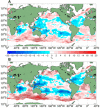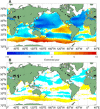Projected 21st century changes in extreme wind-wave events
- PMID: 32577512
- PMCID: PMC7286683
- DOI: 10.1126/sciadv.aaz7295
Projected 21st century changes in extreme wind-wave events
Abstract
We describe an innovative approach to estimate global changes in extreme wave conditions by 2100, as a result of projected climate change. We generate a synthetic dataset from an ensemble of wave models forced by independent climate simulation winds, enhancing statistical confidence associated with projected changes in extreme wave conditions. Under two IPCC representative greenhouse gas emission scenarios (RCP4.5 and RCP8.5), we find that the magnitude of a 1 in 100-year significant wave height (H s ) event increases by 5 to 15% over the Southern Ocean by the end of the 21st century, compared to the 1979-2005 period. The North Atlantic shows a decrease at low to mid latitudes (≈5 to 15%) and an increase at high latitudes (≈10%). The extreme significant wave height in the North Pacific increases at high latitudes by 5 to 10%. The ensemble approach used here allows statistical confidence in projected changes of extremes.
Copyright © 2020 The Authors, some rights reserved; exclusive licensee American Association for the Advancement of Science. No claim to original U.S. Government Works. Distributed under a Creative Commons Attribution NonCommercial License 4.0 (CC BY-NC).
Figures




References
-
- Young I. R., Ribal A., Multiplatform evaluation of global trends in wind speed and wave height. Science 364, 548–552 (2019). - PubMed
-
- Hemer M. A., Fan Y., Mori N., Semedo A., Wang X. L., Projected changes in wave climate from a multi-model ensemble. Nat. Clim. Chang. 3, 471–476 (2013).
-
- Morim J., Hemer M., Wang X. L., Cartwright N., Trenham C., Semedo A., Young I., Bricheno L., Camus P., Casas-Prat M., Erikson L., Mentaschi L., Mori N., Shimura T., Timmermans B., Aarnes O., Breivik Ø., Behrens A., Dobrynin M., Menendez M., Staneva J., Wehner M., Wolf J., Kamranzad B., Webb A., Stopa J., Andutta F., Robustness and uncertainties in global multivariate windwave climate projections. Nat. Clim. Chang. 9, 711–718 (2019).
-
- Hemer M. A., Wang X. L., Church J. A., Swail V. R., Modeling proposal: Coordinating global ocean wave climate projections. Bull. Am. Meteorol. Soc. 91, 451–454 (2010).
-
- N. Veritas, Environmental Conditions and Environmental Loads (Det Norske Veritas, 2000).
LinkOut - more resources
Full Text Sources

